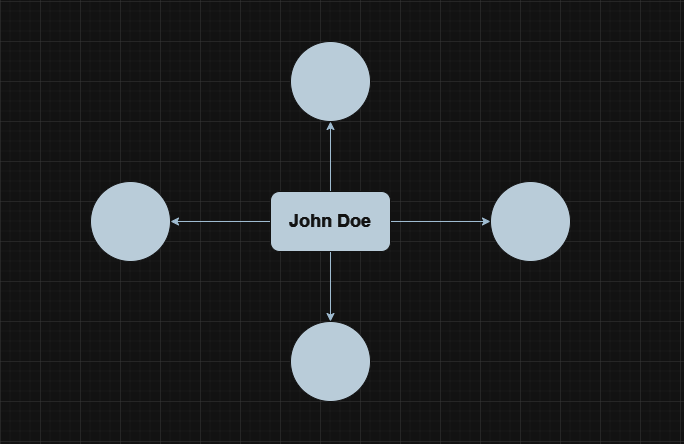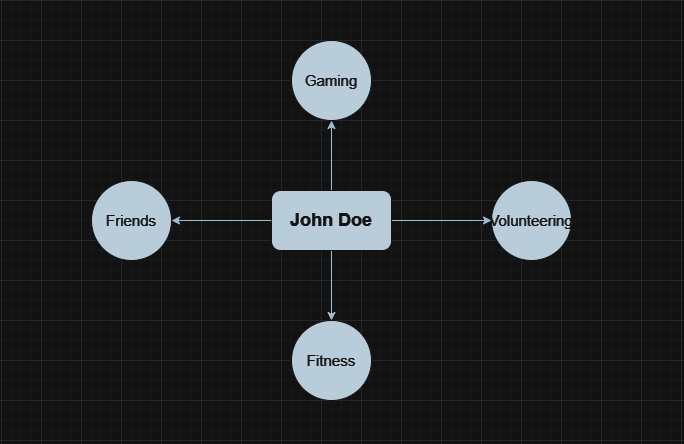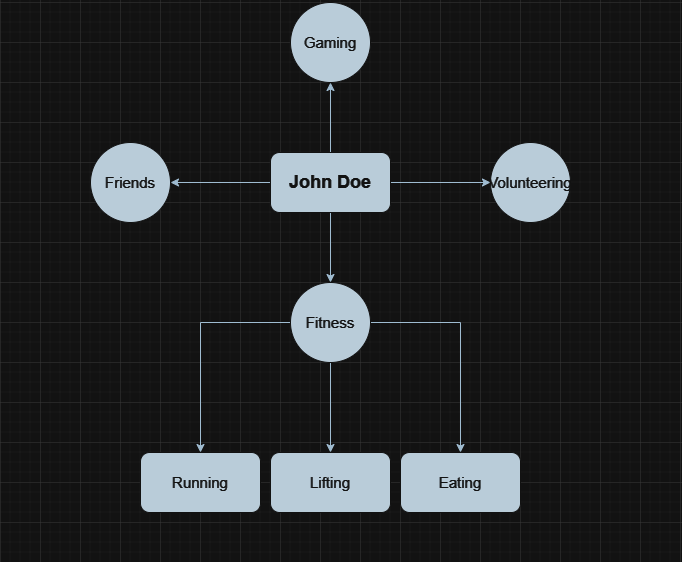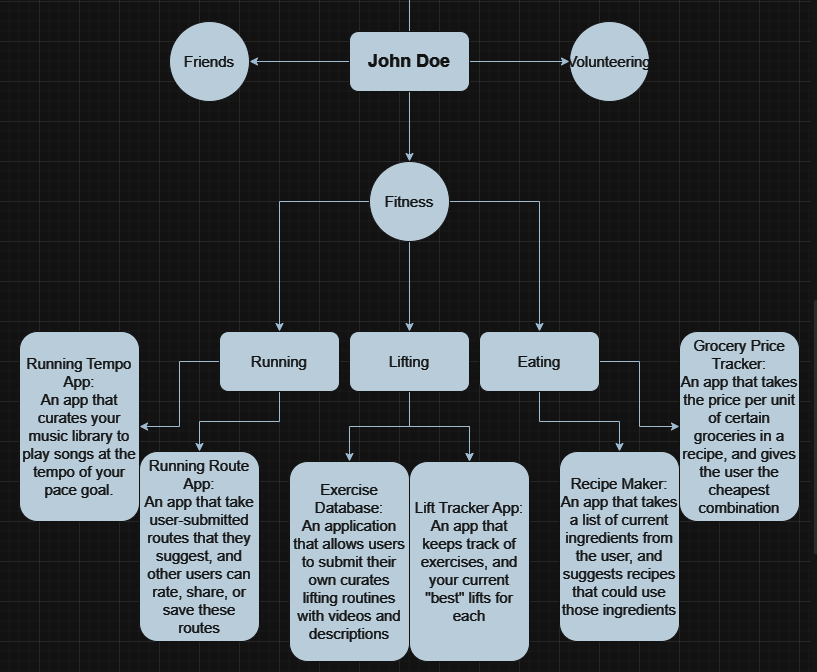📓 4.1.4.2 Capstone Prep: Introduction to Idea Boards
For this section’s independent project, you’ll be doing something different as we’ve mentioned earlier. Instead of focusing on a project directly related to Functional Programming, you’ll start exploring ideas to pursue for your large capstone project that will bookend your Epicodus experience.
We’re introducing this concept early, as we want to make sure you have ample time to get used to the brainstorming process, as well as have feedback before you arrive at the stage that you’re writing code!
For this lesson, we’ll explore one of the core concepts that we’d like you to explore: Idea Boards.
Overview of Idea Boards
Thomas Edison is credited for saying “Genius is one percent inspiration and ninety-nine percent perspiration” and for this upcoming code review we’re going to focus on the inspiration portion of your Capstone. One method for generating inspiration is creating an idea board, or idea web. With an idea board you might start by thinking of the various aspects of your life. These can range from your interests, family life, daily routines, or any challenges or hurdles that you encounter frequently.
In the board below we have a user that has broken up their idea board into Outdoor Activities, Family, Friends, and Hobbies. Beyond that, the example expands those categories by listing relevant people, places, and things that fit within those categories.
For example, below in the Hobbies category our user has expressed interests in Travel, Cooking, and Finance
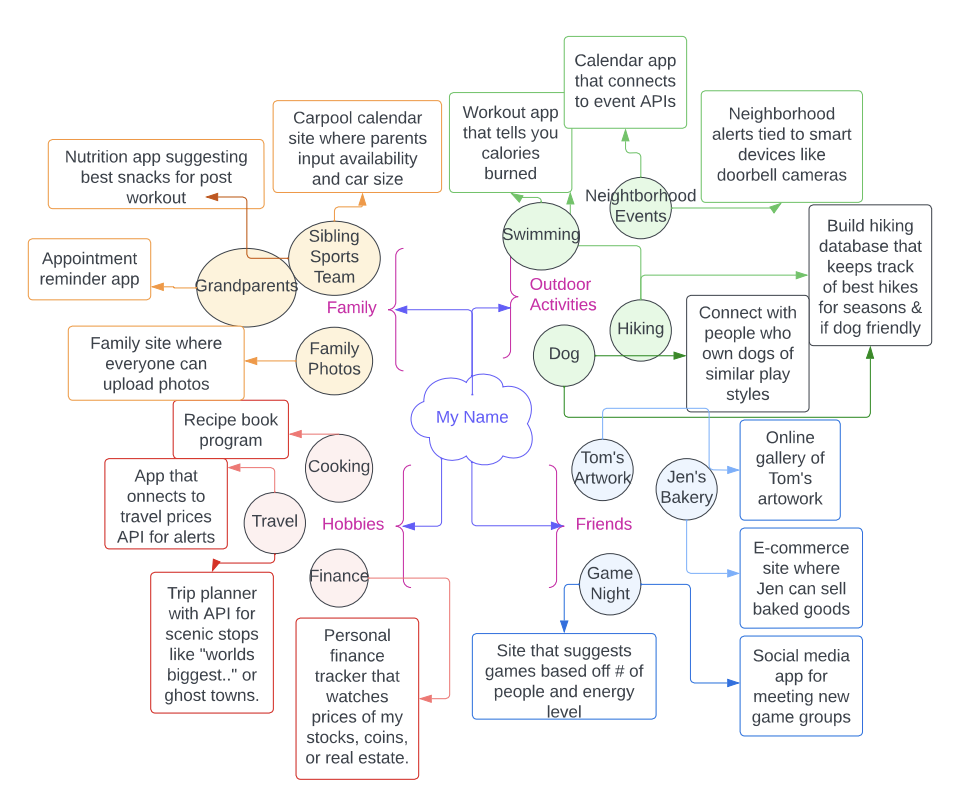
Finally, in the example, there are distilled ideas that can be attached to those interests, places, people, activities, and so on. An example application could be something that enhances an experience, or solves a problem.
Creating Your Own
Now that we have a basic overview of what an Idea Board might look like, or how it will function, let’s take a deeper look at how an individual might go about creating one, and deciding on an application to pursue based upon the board.
Let’s take a look at an example student’s work in progress idea board to take a closer look at the workflow that someone might take to discover their ideal Capstone project.
Above, we have an example of John Doe’s idea board which is currently empty. Thinking about his day-to-day life, John defines a list of interests, hobbies, activities, and his friends.
John might write that he’s interested in Gaming, Fitness, Volunteering, and Friends. He might fill out his idea board like so:
For brevity, we'll now focus on just one section of the tree; Fitness.
John has determined that he has three major focal points that make him passionate about fitness. Running, Lifting, and Eating.
Here’s a quick breakdown of what John may have considered when he chose these three items within Fitness:
Things John enjoys
- John enjoys running long distances around his local area every morning at sunrise
- John enjoys going to the gym and trying to get stronger by lifting heavy weights
- John enjoys cooking and trying new recipes while trying to meet his own nutritional goals and tastes
Expanding from here, John might think about what hurdles and obstacles he has with each of these passions.
Things John finds difficult that could be improved
- John is new to the area, and is having difficulty finding good running routes that aren’t very hilly
- John enjoys tracking his workouts, but has a hard time keeping all of the information on a piece of paper
- John always has leftover ingredients that go to waste after he’s completed cooking the meals he’s planned, and isn’t sure how to use them.
Alternatively, John could think about what might enhance his interests as they are.
Things John might want to add to his interests
- John wants to find a way to increase his pace while running in a metered way
- John wants to try new workouts but doesn’t know where to begin
- John wants to try to lower his grocery price tag while shopping for his meal planning
Using these potential avenues, John might write application ideas that could help pursue overcoming obstacles or improving his interests:
John’s gone ahead and spitballed some ideas that might fit his needs, even without really knowing what technologies or hurdles he might encounter during the development process. But now he has a list of applications that he could consider later on when wanting to practice new skills.
Here’s what he came up with:
Running
- Running Tempo App: An app that curates your music library to play songs at the tempo of your pace goal.
- Running Route App: An app that take user-submitted routes that they suggest, and other users can rate, share, or save these routes
Lifting
- Exercise Database: An application that allows users to submit their own curates lifting routines with videos and descriptions
- Lift Tracker App: An app that keeps track of exercises, and your current "best" lifts for each
Eating
- Recipe Maker: An app that takes a list of current ingredients from the user, and suggests recipes that could use those ingredients
- Grocery Price Tracker: An app that takes the price per unit of certain groceries in a recipe, and gives the user the cheapest combination
If John wanted to continue filling out this idea board, he could do the same for each of his interests - or he could go even further by adding more ideas to this section. He may even decide to combine certain ideas into one to make a larger project that covers multiple interests!
Closing Out
In the examples we’ve gone over, you might see that there are boundless possibilities and opportunities to create an application that could work for you.
As a reminder, at this stage you’re not expected to be thinking about what technologies might be the best solution to your problem. You’re also certainly not expected to stick with the idea you choose at this point. Hopefully, however, this will give you a great starting point in your brainstorming to come up with an idea you’re excited about!
